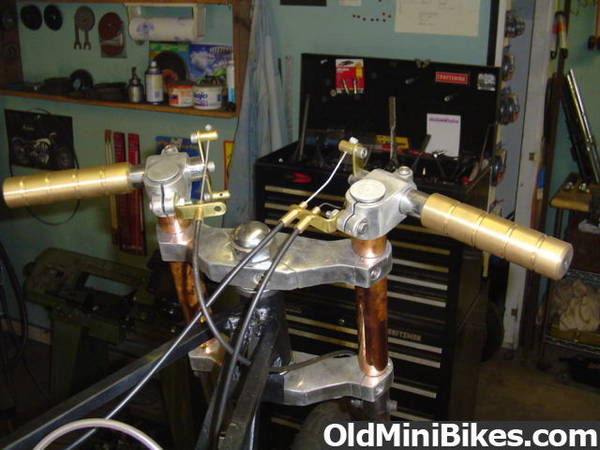This project is to make a pair of rotary hand controls for the Yellowjacket speedster minibike...another ongoing project also listed in this section.
Pic 1- The controls will be similiar to this pair, made for the Ball & Chain bike, but slightly larger, and made from silicon bronze instead of billet aluminum.
Pic 2- Another pair machined in billet aluminum for a friends bike. I tried to talk him out of the spiked grips, but he insisted. I punctured my forehead while assembling the grips to the bike up on the build bench. They may look cool, but they're dangerous. This bike was built for a very young girl to ride.
Pic 3- I originally designed these controls for a custom project to convert a junked old Japanese bike into a cafe racer with as many odd and handmade parts as possible. This is the original sketch I made for the controls while we were sitting around discussing possible parts to make for the build.
Pic 4- This isn't our bike...ours is a Kaw KZ...just a pic to show what can be done with a junker and some skill. This bike was originally a really crappy CB 750, pulled from a pile.
Pic 5- To me, a project isn't interesting if I just grab some new material and throw it in a CNC machine. This project will be done in my garage, with cheap, simple tools, and using as much scrap material as possible. The controls will be made from scrap silicon bronze and brass I pulled off an old wooden sloop in the salvage yard.
Pic 1- The controls will be similiar to this pair, made for the Ball & Chain bike, but slightly larger, and made from silicon bronze instead of billet aluminum.
Pic 2- Another pair machined in billet aluminum for a friends bike. I tried to talk him out of the spiked grips, but he insisted. I punctured my forehead while assembling the grips to the bike up on the build bench. They may look cool, but they're dangerous. This bike was built for a very young girl to ride.
Pic 3- I originally designed these controls for a custom project to convert a junked old Japanese bike into a cafe racer with as many odd and handmade parts as possible. This is the original sketch I made for the controls while we were sitting around discussing possible parts to make for the build.
Pic 4- This isn't our bike...ours is a Kaw KZ...just a pic to show what can be done with a junker and some skill. This bike was originally a really crappy CB 750, pulled from a pile.
Pic 5- To me, a project isn't interesting if I just grab some new material and throw it in a CNC machine. This project will be done in my garage, with cheap, simple tools, and using as much scrap material as possible. The controls will be made from scrap silicon bronze and brass I pulled off an old wooden sloop in the salvage yard.
Last edited:


